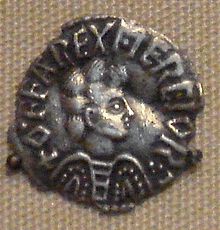- Coinage in Anglo-Saxon England
-
Coinage in Anglo-Saxon England refers to the use of coins, either for monetary value or for other purposes, in Anglo-Saxon England during the Early Mediaeval period.
Archaeologists have uncovered large quantities of coins dating to the Anglo-Saxon period, either from hoards or stray finds, making them one of the most plentiful kinds of artefact that survives from this era. Anglo-Saxonist M.A.S. Blackburn noted that they provided "a valuable source of evidence for economic, administrative and political history."[1]
Contents
History
5th to 7th centuries
As the period of Roman Britain came to an end in the early 5th century CE, when the Roman Army and administrative forces left and returned to Italy, the production of coinage effectively came to an end and a non-monetary economy developed. During that century, Anglo-Saxon tribal groups from continental Europe migrated to central and southern Britain, introducing their own language, polytheistic religion and culture. Although gold coins from continental Europe were traded into Anglo-Saxon England, they were initially used for decorative purposes, only beginning to be used as money in the latter part of the 6th century.[2]
It was around this time that the first Anglo-Saxon coins were produced, although sustained production would not appear until the 630s. These small gold coins were known as scillingas (shillings) in those Anglo-Saxon law codes which survive to us today, although they have since been referred to as thrymsas by numismatists. Modelled on the coins being produced at the same time in Merovingian Francia (geographically the rough equivalent of modern France), these early Anglo-Saxon gold shillings were often inscribed with words borrowed from either Merovingian or Roman coinage, although examples have been found which instead bare the name of King Eadbald of Kent, the moneyers Witmen and Pada, or the names of the mints in London and Canterbury.[3]
Circa 675 the gold shilling was superseded by the silver pening (penny) amongst the Anglo-Saxons, something which would remain the principal monetary denomination until the mid 14th century, during the Late Mediaeval period. These silver pennies were typically decorated with geometric or pictoral designs, occasionally having the name of the moneyer inscribed on them. More rarely, coins produced in the kingdoms of Northumbria and East Anglia had the names of monarchs inscribed on them.[4]
8th to 11th centuries
In the latter part of the 8th century, a new style of silver penny appeared in Anglo-Saxon England, one which was made from thinner fabric and which commonly bore the names of both the king and the moneyer responsible for issuing them. This new type of penny was apparently first introduced under the reign of the powerful and influential King Offa of Mercia circa 760.[5]
There is evidence that in the 9th century, monarchs and their governments gained greater power over the control of coin production, with the designs used by different moneyers becoming more standardised. In the 860s, the Anglo-Saxon kingdoms of Mercia and Wessex formed a monetary alliance by which coinage of a common design could circulate through both of their lands.[6]
References
Footnotes
- ^ Blackburn 1999. p. 113.
- ^ Blackburn 1999. p. 113.
- ^ Blackburn 1999. p. 113.
- ^ Blackburn 1999. p. 113.
- ^ Blackburn 1999. p. 113.
- ^ Blackburn 1999. p. 113.
Bibliography
- Blackburn, M.A.S. (1999). "Coinage". The Blackwell Encyclopaedia of Anglo-Saxon England (Eds: Michael Lapidge, John Blair, Simon Keynes and Donald Scragg) (Oxford: Blackwell): pp. 113-116.
Categories:- Anglo-Saxon England
Wikimedia Foundation. 2010.

